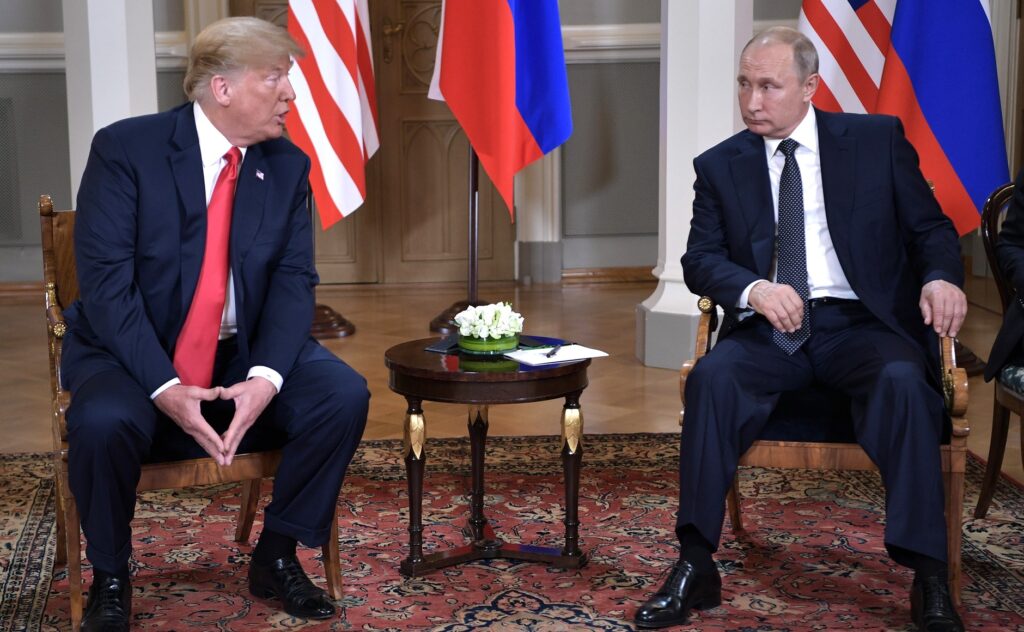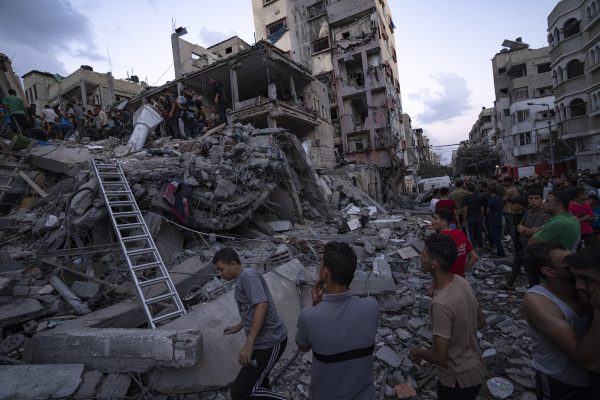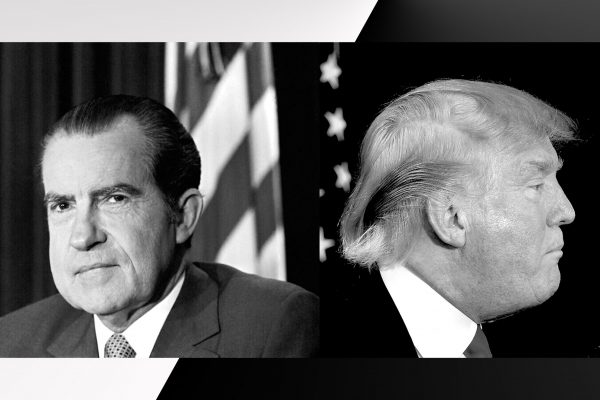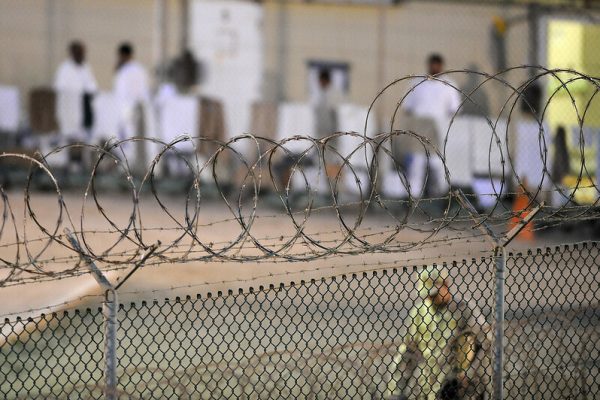The summit in Helsinki between Donald Trump and Vladimir Putin was supposed to put the spotlight on Syria. Instead, that country was again pushed to the margins as attention fixated on whether or not Trump’s comments on Russian meddling in the elections were treasonous.
Whatever the significance of that question for domestic politics, the fact that back channel deal-making over the future of Syria was eclipsed in coverage and conversation speaks to the heedlessness with which the United States has treated the conflict from the beginning.
With the Islamic State (or ISIS) largely defeated, the war has mostly receded from U.S. headlines. But Syria remains gripped by a human tragedy of staggering proportions, with ongoing airstrikes by both Russia and the United States raising the civilian death toll by dozens each day. The Turkish military has besieged Kurdish villages in the country’s north, and the Assad regime has continued its brutal bid to repress opposition at all costs.
Syria is not understood as a U.S. war. But the United States bears real responsibility for the humanitarian tragedy there.
To date, the war has claimed hundreds of thousands of lives and left nearly half the country internally or externally displaced, with a population exodus that has swamped the Middle East and destabilized Europe. Democratic and Republican administrations have shown equal commitment to the U.S. policies that have exacerbated this violence. For those on the left, this means that there is an urgent need to rethink the U.S. approach and to identify a way that both ends the violence and gives primary attention to the interests of Syrians themselves.
Yet as the Trump–Putin summit makes clear once more, for the central external actors, Syria’s fate has never been about what would actually aid the people on the ground, but rather which larger alliances should dominate the region. Indeed, the hand-wringing within the national security establishment that Trump might make a “terrible deal on Syria,” belies the fact that the deal is not actually about that country. As National Security Advisor John Bolton recently underscored, the United States’s strategic objectives in Syria focus on concerns beyond its borders.
At stake for the United States in any possible deal, such as one that potentially trades Ukraine for Syria, is an effort to leverage normalization with Russia for support in confronting the Trump administration’s real regional foe, Iran. In such a grand bargain, the United States might drop its objection to Russia’s absorption of Crimea in exchange for Russia limiting Iran’s role in Syria.
The position held by the Obama administration and also for the first year and a half of the Trump administration, if only by default, that “Assad must go” has now apparently yielded to other priorities. In fact, a visit by Israeli prime minister Benjamin Netanyahu to Russia in advance of the Helsinki summit reportedly paved the way for a Russian commitment to “restrain Iran.” Analyses of Trump’s post-summit remarks suggest that a plan to keep Iranian-backed forces away from the Syrian border with Israel may be an initial move.
The Helsinki Summit shows how one misplaced strategic objective has simply given way to another.
But even as U.S. policy in Syria has shifted, the problem with the U.S. approach to the country and to the Middle East as whole remains the same. Similar to U.S. interventions across the region, the implications for local communities, both in terms of humanitarian costs and meaningful control over their own transition process, do not figure into military and diplomatic decision-making.
To make matters worse, so far as Americans are concerned, Syria is not even understood as a U.S. war. According to the conventional wisdom, the best account for why Bashar al-Assad may remain is that the United States failed to intervene under Obama. But in reality, continuous U.S. intervention, rather than its absence, has played a key part in fueling the blood-letting and hardening the internal divisions.
Indeed, without a proper assessment of the U.S. role in the conflict, it is impossible to make sense of either what should be done now or what humanitarian responsibilities the U.S. directly owes to the Syrian population.
The United States has been involved in the Syrian conflict from the start, from arming and financing regime opponents in the first phases of the uprising, to producing the conditions in Iraq for the rise of ISIS and its subsequent spread to Syria. The United States also deputized Kurdish forces to serve as a proxy ground force while it waged its aerial war against ISIS, and the Trump administration has initiated occasional (and ineffectual) airstrikes against regime targets for alleged chemical weapons use.
Almost every aspect of the persistent U.S. presence in Syria has dramatically escalated the violence and exacerbated the harm to its civilian population. It therefore bears real responsibility for the humanitarian tragedy and must engage in both immediate and more longterm efforts to find an inclusive political settlement and to address the needs of the displaced refugee population (now located on the other side of Syria’s borders with Lebanon, Jordan, Iraq and Turkey).
Beginning in late 2011, the Obama administration pursued a strategy of arming local proxies in the hopes of militarily defeating Syria’s authoritarian leader rather than supporting a negotiated settlement. It wrongly believed that with enough pressure a tipping point could be reached and the Assad regime would fall. This ignored the obvious fact that Syria’s centrality to Iranian and Russian regional security interests meant that these countries would not allow the regime to fall without being given a stake in the future governing arrangement.
With Trump as an accomplice, Saudi Arabia, the United Arab Emirates, and Israel want to shift regional authority away from Iran and towards their own increasingly aggressive coalition.
Militarization therefore led to stalemate—as external actors backed their internal proxies—and inevitably to the splintering of the country. To make matters worse, the Obama administration largely outsourced the coordination of the flows of arms to Gulf states such as Saudi Arabia, which viewed the uprising against Assad in sectarian terms as an effort to promote an anti-Iranian agenda and to strengthen Sunni militias. The result not only left neighborhoods consumed in inter-militia sectarian violence but also created a political space for extremist Sunni groups such as ISIS to operate freely in Syria.
During the early years of the conflict, the United States paired its military strategy with an insistence that it would control the terms of the political negotiations to end the conflict. Beginning in 2011 the White House set two conditions for such talks: that Assad must “step aside” and that Iran could not be included. As a result, two prominent international statesmen charged by the United Nations with forging political settlement in cooperation with the United States resigned from that role—Kofi Annan in 2012 and Lakhdar Brahimi in 2014—noting that the conflict could not be resolved without bringing all parties to the table. By the time the United States dropped its preconditions, the diplomatic initiative had fractured.
There are now three separate tracks, each of which only brings a fraction of the vying power centers to the table. The Geneva track, led by the United Nations with U.S. backing, is currently headed by Staffan de Mistura, an Italian-Swedish diplomat who was appointed as UN envoy to Syria in July 2014 and has been trying to convene Syrian government and opposition delegations for talks “without preconditions” ever since. De Mistura’s efforts are also supported by the so-called small group (the Small Group of the Global Coalition to Defeat ISIS), comprised of France, Britain, Germany, Saudi Arabia, and Jordan, as well as the U.S.
A second track, from which the United States has been excluded, is nominally supported by the UN but actually convened by the Russians and Iranians, with the participation of Turkey, in Astana, Kazakhstan. It should be noted that the U.S. insistence on excluding Iran from the Geneva process set the stage for creating this alternative venue—a venue that at times has overshadowed the UN process. The Astana talks have been continuing since late 2016 and have had at least nine rounds as of this spring.
The third and most recent track emerged earlier this year in Sochi where the Russians convened what they described as a Syrian Congress on National Dialog, as a parallel peace conference to ongoing UN-brokered efforts. For Syrian opposition groups, the Russian-backed Astana and Sochi tracks so favor the Assad regime as to be all but pointless. But without meaningful progress towards a political settlement in the hapless Geneva process some still choose to participate in the Russian convenings to pursue limited short-term objectives, such as the creation of “de-escalation zones” to slow pro-regime Russian airstrikes and to give civilians an opportunity to escape targeted neighborhoods.
‘Diplomacy’ is little more than a pretext for the pursuit of a new military grand strategy—one in which Syria’s civilian population remains, at best, an afterthought.
As for the conflict itself, Assad today has reasserted control over large swaths of Syrian territory due to decisive military assistance from Russia and Iran. But the conflict has morphed well beyond a traditional uprising or even civil war. There are now so many wars raging in the country—between Turkey and the Kurds, Assad and opposition groups, the Gulf states and Iran—that all the continuing violence has no prospect of ending without a broad political settlement that includes a wide range of actors—precisely what none of the diplomatic tracks provide at present. Over the last year, France has called for coordinating the Astana talks with the “small group” to create a context in which each external faction of the conflict is at the table. Following the Helsinki summit, Putin suggested he might be open for such a merger—if he is, it will likely be because he expects simply to dictate the terms.
The longstanding U.S. strategy, especially of hoping to remove the Assad regime by force, has failed. With the combined support of Russia and Iran, the Syrian regime seems poised to prevail over much of the opposition. Trump is now looking to cut his losses in Syria by pivoting to a deal with Russia and renewed confrontation with Iran; he has already stopped aid to the opposition groups the United States once funded and he may soon withdraw the U.S. troops on the ground fighting ISIS.
But the Helsinki Summit highlights that, although the Trump administration has apparently abandoned regime change in Syria, the removal of one misplaced strategic objective has simply given way to another. Syria is now viewed as a terrain for isolating and even attacking Iran. The shift may result in the United States and its Gulf allies eventually acceding to Russian military facts on the ground in Syria, at the cost of the country’s longterm stability and the interests of many of the local constituencies that first participated in the uprising.
Amidst the grand strategy, Syria’s civilian population remains at best an afterthought—consigned to little more than a casual aside by Trump in his news conference with Putin. For Trump, Syrian civilians are just collateral damage and not even clearly entitled to humanitarian assistance.
Missing from all the negotiations to date has been any genuine effort to bring the conflict as a whole to a peaceful and inclusive end. And true to form, the Trump–Putin summit had no such ambition. Just as the alleged non-intervention of the United States in the Syrian conflict provided cover for continuous intervention, “diplomacy” over Syria is little more than a pretext for the pursuit of a new military grand strategy.
It is long past time for a genuine U.S. reorientation to the Middle East, but Democrats have been embarrassingly silent on the matter.
Bolton’s comments that Syria is at best a sideshow helpfully illustrate how the U.S. willingness to talk is ultimately the continuation of the Trump administration’s war footing towards Iran. In fact, for all the news focus on Russia’s involvement in the 2016 election, the summit should importantly be understood against the backdrop of the Trump administration’s ties to Saudi Arabia, the United Arab Emirates, and Israel. The goals of those tacitly allied powers is to shift regional authority away from Iran and towards their own increasingly aggressive coalition. President Trump has been the most willing U.S. accomplice yet to this plan.
In many ways, the U.S. withdrawal from the Iran nuclear deal was the first volley in this effort to reconfigure the Middle East. That withdrawal had little to do with Iran’s ballistic missile program, caps on uranium enrichment, or any other purported concerns about arms control. The problem with the deal was the risk of “normalizing” Iran by relaxing sanctions that have crippled its economy. From the perspective of the Saudis, the Emiratis, and the Israelis, the imperative is to weaken Iran through a combination of sanctions and threats—including of strikes against its nuclear facilities—in pursuit of regime change or at the very least containment of the kind achieved by sanctions against Iraq in the 1990s.
The Trump administration is only too ready to join in this effort. For an administration led by a president seeking closer ties to Russia and filled with Iran hawks (that have long called for regime change through bombing), the Helsinki summit served as the perfect opportunity to demonize Iran while demonstrating that the United States can do business with Putin.
In the process, the United States’s intervention in Syria is essentially a chess move in a larger game, one that unsurprisingly generates yet more regional tension. The war with Iraq produced the blowback that destabilized Syria and gave rise to ISIS, necessitating intervention, and now the war in Syria has become a proxy for escalating confrontation with Iran. The United States’s military footprint in the Middle East—together with the aggressive actions of its Gulf allies, Israel, and Turkey—has metastasized the conflicts now engulfing the region.
But instead of taking responsibility for ending the violence, the Trump administration is poised to spread it further.
Part of what has perpetuated these cycles of confrontation has been the total absence of an alternative policy approach within Washington, D.C.—including among left-leaning Democratic politicians, even those associated with the Sanders wing of the party.
The Obama–Clinton focus on regime change has failed and the Trump administration is using the cover of “diplomacy” to pursue a belligerent posture toward Iran. But despite the obvious flaws of both approaches, they remain the only options on the table. Indeed, U.S. Middle East policy continues to be trapped by two variants of the same national security hawkishness, a hawkishness that has been directly responsible over many decades for the region’s various catastrophes—with Iraq and Libya as recent examples.
The United States should ensure the protection of people who are subject to mass atrocity in part due to the folly of its own policies.
It is long past time for a genuine U.S. reorientation to the region and Syria offers a clear opportunity to begin this effort. Furthermore, even if one cannot expect such a change from the current administration, at the very least it must be demanded of ostensibly progressive Democrats who seek to replace Trump and who have been embarrassingly silent on the matter.
With this in mind, what would an actual alternative approach amount to—given the United States’s own role in the conflict and the multitude of actors and interests now jostling for position in the country? To begin with, rather than enabling Sunni Gulf states such as Saudi Arabia and the United Arab Emirates in their quest to bleed Iran, the U.S. could rein in ongoing Gulf finance and support for militias on the ground in Syria and demand that these countries support a political process. This would require breaking with the Gulf’s and Israel’s desire to isolate Iran and ratchet up military tensions.
Such a de-escalation of the orientation to Iran would have many other entailments, requiring a broader realignment of the United States’s approach to the region. For instance, the United States should not only return to the nuclear deal—something Israel and Saudi Arabia pushed hard for Trump to abandon—but also open up an actual dialogue with Iran over the future of U.S.–Iranian relations throughout the region.
In fact, one of the lasting problems with how the Obama administration pursued the nuclear negotiations was that such negotiations proceeded while the United States simultaneously sought to exclude Iran from the diplomatic framework for Syria structured by the UN. Not only did this undermine a peaceful resolution in Syria, it also created deep internal tensions within U.S. policy—with the Obama officials ratcheting down violence in one context as they pursued confrontation with Iran in another.
A summit such as the one in Helsinki between Trump and Putin should be oriented towards objectives that would advance sustainable and inclusive peace in Syria, including an end to airstrikes on all sides, rather than treating the country as a sideshow in a battle to confront Iran. Unlike in the spring of 2012, when a genuine commitment to negotiations by the United States might have made an inclusive political settlement in Syria easier to attain, today the balance of military power on the ground has placed Russia and Iran in the driver seat. Due, in part, to the faulty U.S. logic six years ago that militarizing the conflict further would enhance the position of its Gulf allies, the United States is now reduced to using its leverage to persuade Russia to turn its advantage into meaningful political negotiations for Syria’s future.
But calling for such negotiations must not become an occasion to merely sanction the continuation of Assad’s brutal rule. Rather the United States should support—and demand that Russia back—negotiations designed to allow a transition that incorporates a wide range of actors across Syria’s political spectrum.
Finally, the United States should facilitate an agreement with Turkey to withdraw from Syrian territory in exchange for assurances that Kurdish autonomy goals would be pursued within Syria’s current borders rather than through secession.
Those actors complicit in Syria’s destruction are obligated to help resettle refugees and provide basic needs to the nearly eight million displaced.
The key goal of all of this would be to limit the hostilities and restrain external interveners in ways that create the actual space for Syrians on the ground to pursue a transition process that they themselves direct. This is of course much easier said than done, given the transnational reality of the conflict, the extreme violence of Assad as well as his strengthened position, and the fragmented nature of the various militias across the country.
But in a context in which the militarized interventions of key states have transformed a local uprising into a regional proxy war, such an inclusive framework—facilitated by external restraint and the political space it creates—remains the only possibility, however tenuous, for refocusing transnational politics in Syria around local demands. As the other options have made clear, allowing regional actors to fight over the country has led to a might-makes-right strategy with terrible consequences.
The problem, of course, is that actually pursuing these policies—and holding states such as Saudi Arabia, Israel and Turkey accountable for their own violence—means seriously reframing the terms of U.S. regional alliances. Neither Democrats nor Republicans have shown any capacity to do this.
Instead, opinion leaders on the Democratic side worry that Trump will give away U.S. “leverage” in Syria—by withdrawing remaining U.S. troops as part of a deal with Putin—while Republicans call for greater aggression against Iran. For those on the left, it is well past the time to press a shift in the U.S. approach to the Middle East.
But U.S. obligations do not stop there. Even if an inclusive political settlement were achieved tomorrow, the profound destruction of civilian infrastructure in much of Syria and the absence of a central body capable of ensuring public order, let alone reconstruction, is so great that repatriating refugees and internally displaced persons is not possible at present. In some ways, the talks in Helsinki and elsewhere are a diversion from the more urgent humanitarian crisis confronting the international community.
The overriding and immediate obligation of those actors complicit in Syria’s destruction is the resettlement of refugees outside of Syria and the provision of basic needs—subsistence, shelter, health and education—to the nearly eight million displaced within Syria.
Even if the conflict is drawing to a close, not all settlements are created equal.
The United States should follow its own past practices when civilians have fled conflicts the country was itself involved in. For instance, around 140,000 Vietnamese were resettled in the United States in 1975 alone, followed by more than 300,000 over the next decade. Given our role in Iraq and our participation from the beginning in ratcheting up violence in Syria, the United States should similarly commit to taking in 400,000 Syrians over four years—a figure that is less than 10 percent of the number currently absorbed by neighboring countries.
The United States should also raise the lion’s share of financing (some of it from the Gulf) for UN and international agency relief efforts for those in Turkey, Lebanon, Jordan, Iraq and Egypt. And it must organize international burden sharing arrangements to support frontline host countries and secondary countries at EU borders. Russia and Iran, in turn, must be called upon to persuade Assad to facilitate the provision of humanitarian assistance to internally displaced persons (IDPs) within Syria.
The tragedy in Syria is not some distant affair. It is partly the product of the disastrous Iraq war and it has been compounded by foreseeable errors made by three successive U.S. administrations. Even if the conflict is drawing to a close, it is critical to realize that not all settlements are created equal and that the United States’s diplomatic and humanitarian obligations remain just as pressing. It is therefore up to the leadership in Washington to fulfill its responsibilities.
The Trump administration has chosen, through orders such as the Muslim ban, to shut the door to civilians the country has actively put in harm’s way. In a sense, such measures are an extreme embodiment not only of the current administration’s moral culpability but also of the ethical blindness that has shaped seven years’ worth of policymaking.
If anything, the current conversation in Washington—whether to shut the door entirely or offer any assistance at all in reconstruction—is the exact inverse of what it should be: how systematically can the United States ensure the protection of an entire population subject to mass atrocity in part due to the folly of our own policies?
If Trump and his administration refuse to be held accountable for their actions in Syria—as they have similarly refused across a range of other issues—the very least we should require is that his political opponents in Democratic circles own up to U.S. complicity and agree to pay back this country’s debt.








